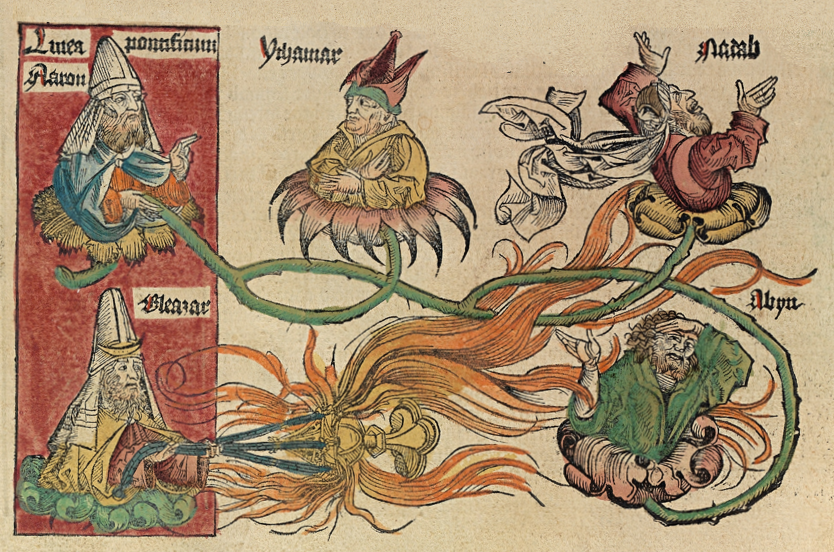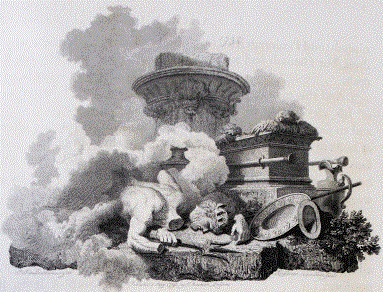|
Jewish Priests
Kohen (, ; , ، Arabic كاهن , Kahen) is the Hebrew word for "priest", used in reference to the Aaronic priesthood, also called Aaronites or Aaronides. They are traditionally believed, and halakhically required, to be of direct patrilineal descent from the biblical Aaron (also ''Aharon''), brother of Moses, and thus belong to the Tribe of Levi. During the existence of the Temple in Jerusalem (and previously the Tabernacle), ''kohanim'' performed the Temple sacrificial offerings, which were only permitted to be offered by them. Following its destruction, it seems that most of them joined the Synagogal Jewish movement before adopting gradually Rabbinic Judaism, other types of Judaism, Christianity or Islam. Today, ''kohanim'' retain a lesser though distinct status within Rabbinic and Karaite Judaism, including certain honors and restrictions. In the Samaritan community, the kohanim have remained the primary religious leaders. Ethiopian Jewish religious leaders are calle ... [...More Info...] [...Related Items...] OR: [Wikipedia] [Google] [Baidu] |
Priest
A priest is a religious leader authorized to perform the sacred rituals of a religion, especially as a mediatory agent between humans and one or more deity, deities. They also have the authority or power to administer religious rites; in particular, rites of sacrifice to, and propitiation of, a deity or deities. Their office or position is the "priesthood", a term which also may apply to such persons collectively. A priest may have the duty to hear confessions periodically, give marriage counseling, provide prenuptial counseling, give spiritual direction, teach catechism, or visit those confined indoors, such as the sick in hospitals and nursing homes. Description According to the trifunctional hypothesis of prehistoric Proto-Indo-European society, priests have existed since the earliest of times and in the simplest societies, most likely as a result of agricultural surplus#Neolithic, agricultural surplus and consequent social stratification. The necessity to read sacred text ... [...More Info...] [...Related Items...] OR: [Wikipedia] [Google] [Baidu] |
Beta Israel
Beta Israel, or Ethiopian Jews, is a Jewish group originating from the territory of the Amhara Region, Amhara and Tigray Region, Tigray regions in northern Ethiopia, where they are spread out across more than 500 small villages over a wide territory, alongside predominantly Christianity in Ethiopia, Christian and Islam in Ethiopia, Muslim populations. Most of them were concentrated mainly in what is today North Gondar Zone, Shire Inda Selassie, Welkait, Wolqayit, Tselemti, Dembia, Segelt, Qwara Province, Quara, and Belesa. After the founding of the Israel, State of Israel, most of the Beta Israel Aliyah, immigrated there or were evacuated through several initiatives by the Israeli government starting from 1979. The ethnogenesis of the Beta Israel is disputed with Genetic studies of Jews, genetic studies showing them to cluster closely with non-Jewish Amhara people, Amharas and Tigrayans with no indications of gene flow with Yemenite Jews in spite of their geographic proximity. ... [...More Info...] [...Related Items...] OR: [Wikipedia] [Google] [Baidu] |
Nuremberg Chronicles F 29v 2
Nuremberg (, ; ; in the local East Franconian dialect: ''Nämberch'' ) is the Franconia#Towns and cities, largest city in Franconia, the List of cities in Bavaria by population, second-largest city in the States of Germany, German state of Bavaria, and its 544,414 (2023) inhabitants make it the List of cities in Germany by population, 14th-largest city in Germany. Nuremberg sits on the Pegnitz (river), Pegnitz, which carries the name Regnitz from its confluence with the Rednitz in Fürth onwards (), and on the Rhine–Main–Danube Canal, that connects the North Sea to the Black Sea. Lying in the Bavarian Regierungsbezirk, administrative region of Middle Franconia, it is the largest city and unofficial capital of the entire cultural region of Franconia. The city is surrounded on three sides by the , a large forest, and in the north lies (''garlic land''), an extensive vegetable growing area and cultural landscape. The city forms a continuous conurbation with the neighbouring ... [...More Info...] [...Related Items...] OR: [Wikipedia] [Google] [Baidu] |
Yitro
Yitro, Yithro, Yisroi, Yithre, Yisrau, or Yisro (, Hebrew language, Hebrew for the name "Jethro (Bible), Jethro," the second word and incipit, first distinctive word in the parashah) is the seventeenth weekly Torah portion (, ''parashah'') in the annual Judaism, Jewish cycle of Torah reading and the fifth in the Book of Exodus. The parashah tells of Jethro's organizational counsel to Moses and God in Judaism, God's revelation of the Ten Commandments to the Israelites at Biblical Mount Sinai, Mount Sinai. The parashah constitutes Exodus 18:1–20:23. The parashah is the shortest of the weekly Torah portions in the Book of Exodus and is also one of the shortest parashot in the Torah. It is made up of 4,022 Hebrew letters, 1,105 Hebrew words, and 75 Chapters and verses of the Bible, verses. Jews read it the seventeenth Shabbat, Sabbath after Simchat Torah, generally in January or February. Jews also read part of the parashah, Exodus 19:1–20:23, as a Torah reading on the first day ... [...More Info...] [...Related Items...] OR: [Wikipedia] [Google] [Baidu] |
Mekhilta Of Rabbi Ishmael
The Mekhilta of Rabbi Ishmael ( IPA , "a collection of rules of interpretation") is midrash halakha to the Book of Exodus. The Aramaic title ''Mekhilta'' corresponds to the Mishnaic Hebrew term ' "measure," "rule", and is used to denote a compilation of exegesis ( ''middoṯ''; compare talmudical hermeneutics). Other important mekhiltas were those of Shimon bar Yochai and on Book of Deuteronomy. The latter work was also associated with Rabbi Ishmael's teachings. According to Steven Fine, both ''Sifra'' and the ''Mekhilta I.'' were concerned with the sanctification of early study houses after the destruction of the Second Temple. Authorship The author or redactor of the Mekhilta cannot be definitely ascertained. Nissim ben Jacob and Samuel ibn Naghrillah refer to it as the ''Mekhilta de-Rabbi Yishmael'', thus ascribing the authorship to Ishmael. Maimonides likewise says: "R. Ishmael interpreted from 've'eleh shemot' to the end of the Torah, and this explanation is cal ... [...More Info...] [...Related Items...] OR: [Wikipedia] [Google] [Baidu] |
Targum Yonatan
The Targum Jonathan () is the Aramaic translation of the Nevi'im section of the Hebrew Bible employed in Lower Mesopotamia ("Babylonia"). It is not to be confused with "Targum Pseudo-Jonathan," an Aramaic translation of the Torah. It is often known as "Targum Jonathan" due to a printer's error or perhaps because it is so stylistically similar to the Targum Jerusalem, which is named "Jonathan" to differentiate the two later translations. Origin Like Targum Onkelos, it originated in the synagogue reading of a translation from the Nevi'im, which was part of the weekly lesson. The Talmud attributes its authorship to Jonathan ben Uzziel, a pupil of Hillel the Elder, in Megillah 3a:4. According to this source, it was composed by Jonathan ben Uzziel "from the mouths of Haggai, Zechariah, and Malachi," implying that it was based on traditions derived from the last prophets. The additional statements that, on this account, the entire land of Israel was shaken and that a voice from ... [...More Info...] [...Related Items...] OR: [Wikipedia] [Google] [Baidu] |
Dagon
Dagon or Dagan (; ) was a god worshipped in ancient Syria, across the middle of the Euphrates, with primary temples located in Tuttul and Terqa, though many attestations of his cult come from cities such as Mari and Emar as well. In settlements situated in the upper Euphrates area, he was regarded as the "father of gods" similar to Mesopotamian Enlil or Hurrian Kumarbi, as well as a lord of the land, a god of prosperity, and a source of royal legitimacy. A large number of theophoric names, both masculine and feminine, attests that he was a popular deity. He was also worshiped further east, in Mesopotamia, where many rulers regarded him as the god capable of granting them kingship over the western areas. Attestations of Dagan from coastal areas are much less frequent and come mostly from the northern city of Ugarit, where Dagan's cult had a limited scope. According to the Hebrew Bible, Dagan was also the national god of the Philistines, with temples at Ashdod and Gaza, but ... [...More Info...] [...Related Items...] OR: [Wikipedia] [Google] [Baidu] |
Baal
Baal (), or Baʻal, was a title and honorific meaning 'owner' or 'lord Lord is an appellation for a person or deity who has authority, control, or power (social and political), power over others, acting as a master, chief, or ruler. The appellation can also denote certain persons who hold a title of the Peerage o ...' in the Northwest Semitic languages spoken in the Levant during Ancient Near East, antiquity. From its use among people, it came to be applied to gods. Scholars previously associated the theonym with solar god, solar cults and with a variety of unrelated patron deity, patron deities, but inscriptions have shown that the name Ba'al was particularly associated with the storm god, storm and fertility god Hadad and his local manifestations. The Hebrew Bible includes use of the term in reference to various Levantine mythology, Levantine deities, often with application towards Hadad, who was decried as a false god. That use was taken over into Christianity and Isl ... [...More Info...] [...Related Items...] OR: [Wikipedia] [Google] [Baidu] |
Hebrew Bible
The Hebrew Bible or Tanakh (;"Tanach" . '' Random House Webster's Unabridged Dictionary''. ; ; or ), also known in Hebrew as (; ), is the canonical collection of scriptures, comprising the Torah (the five Books of Moses), the Nevi'im (the Books of the Prophets), and the [...More Info...] [...Related Items...] OR: [Wikipedia] [Google] [Baidu] |
Noun
In grammar, a noun is a word that represents a concrete or abstract thing, like living creatures, places, actions, qualities, states of existence, and ideas. A noun may serve as an Object (grammar), object or Subject (grammar), subject within a phrase, clause, or sentence.Example nouns for: * Living creatures (including people, alive, dead, or imaginary): ''mushrooms, dogs, Afro-Caribbeans, rosebushes, Mandela, bacteria, Klingons'', etc. * Physical objects: ''hammers, pencils, Earth, guitars, atoms, stones, boots, shadows'', etc. * Places: ''closets, temples, rivers, Antarctica, houses, Uluru, utopia'', etc. * Actions of individuals or groups: ''swimming, exercises, cough, explosions, flight, electrification, embezzlement'', etc. * Physical qualities: ''colors, lengths, porosity, weights, roundness, symmetry, solidity,'' etc. * Mental or bodily states: ''jealousy, sleep, joy, headache, confusion'', etc. In linguistics, nouns constitute a lexical category (part of speech) defined ... [...More Info...] [...Related Items...] OR: [Wikipedia] [Google] [Baidu] |
Arabic
Arabic (, , or , ) is a Central Semitic languages, Central Semitic language of the Afroasiatic languages, Afroasiatic language family spoken primarily in the Arab world. The International Organization for Standardization (ISO) assigns language codes to 32 varieties of Arabic, including its standard form of Literary Arabic, known as Modern Standard Arabic, which is derived from Classical Arabic. This distinction exists primarily among Western linguists; Arabic speakers themselves generally do not distinguish between Modern Standard Arabic and Classical Arabic, but rather refer to both as ( "the eloquent Arabic") or simply ' (). Arabic is the List of languages by the number of countries in which they are recognized as an official language, third most widespread official language after English and French, one of six official languages of the United Nations, and the Sacred language, liturgical language of Islam. Arabic is widely taught in schools and universities around the wo ... [...More Info...] [...Related Items...] OR: [Wikipedia] [Google] [Baidu] |
Phoenicia
Phoenicians were an Ancient Semitic-speaking peoples, ancient Semitic group of people who lived in the Phoenician city-states along a coastal strip in the Levant region of the eastern Mediterranean, primarily modern Lebanon and the Syria, Syrian coast. They developed a Maritime history, maritime civilization which expanded and contracted throughout history, with the core of their culture stretching from Arwad in modern Syria to Mount Carmel. The Phoenicians extended their cultural influence through trade and colonization throughout the Mediterranean, from Cyprus to the Iberian Peninsula, evidenced by thousands of Canaanite and Aramaic inscriptions, Phoenician inscriptions. The Phoenicians directly succeeded the Bronze Age Canaanites, continuing their cultural traditions after the decline of most major Mediterranean basin cultures in the Late Bronze Age collapse and into the Iron Age without interruption. They called themselves Canaanites and referred to their land as Canaan, but ... [...More Info...] [...Related Items...] OR: [Wikipedia] [Google] [Baidu] |






